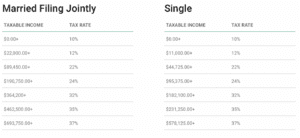The Internal Revenue Service (IRS) has announced a 7.1% adjustment for tax brackets in 2023, one of the highest adjustments we’ve seen in decades, meaning that more income can be protected from taxes.1Additionally, with newly raised standard deduction amounts, married couples will now benefit from a bump of $1,800 to $27,700 and single filers are looking at an increase of $900 to $13,850.
In addition to new income tax brackets and higher standard deductions for 2023, the IRS has announced higher contribution limits for 401(k)s, IRAs, and HSAs. If you’re thinking about retirement planning or have been planning for years, now is a good time to review your options to ensure you’re on track and taking advantage of changes to contribution limits.
Here’s what you need to know about the changes in income tax brackets and deductions, and how they might affect your retirement savings plans.
- The higher your bracket is, the less you’ll pay in taxes on contributions made to traditional IRAs or 401(k)s. You may also be eligible for additional credits and deductions when your income falls into certain brackets.
- The 2023 income tax brackets are based on your modified adjusted gross income (MAGI). Amounts of taxable income that fall into each bracket will increase as well. The standard deduction for single filers, married couples filing jointly, and heads of household is increased 7.1% in 2023.
- For 2023, the limit on traditional IRA contributions has risen to $6,500, or $7,500 if you’re over age 50. The limit on 401(k) contributions has also increased to $22,500, or $27,000 if you’re over age 50.
- Estate tax exemption amount increased to $12.92 Million*, gift tax exemption amount increased to $12.92 Million*, and gift tax annual exclusion amount: $17,000*2.
Why Do Tax Brackets Change?
Different income tax brackets are designed to reflect progressive taxation, in which those who can afford to pay a higher proportion of their income, do so. As economic factors, such as inflation and wages fluctuate over time, the Internal Revenue Service (IRS) often adjusts income tax brackets accordingly on an annual basis using a cost-of-living adjustment (COLA). This helps to ensure that most citizens are not adversely affected by changes in circumstances beyond their control, while still collecting appropriate revenue from taxpayers.

Source: American Century Investments
Managing Your Tax Bracket Changes
Measures have been recently imposed to help Americans manage the changes in their tax brackets and benefit from a higher standard deduction. Knowing the two ways of taking deductions on your federal income tax return – itemized or standard deductions – can be valuable in assessing how much you will owe in taxes each year. The standard deduction is calculated as a fixed amount that you are eligible to deduct from your taxable income; while an itemized deduction requires calculating expenses such as medical costs, interest payments, etc., that total up to more than the fixed amount of the standard deduction. Knowing which type of deductions are available and how they can affect your taxes is an effective way to manage tax bracket changes. Make sure to consult with your accountant on these changes prior to filing taxes this year.
Contribution Limits
When it comes to retirement savings, your income tax bracket is an important factor. The higher your bracket is, the less you’ll pay in taxes on contributions made to traditional IRAs or 401(k)s. You may also be eligible for additional credits and deductions when your income falls into certain brackets. For 2023, the top tax rate is 37%.
For savers, 401(k) plans, IRAs, and HSAs now have increased contributions, meaning if you’re already maxing out your contributions, you can now allocate even more money towards your retirement. Additionally, money invested in either a 401(k) or an IRA is withheld and not taxed until you begin your retirement withdrawals.
- 401(k): Participants can contribute up to $22,500 (pretax) and individuals 50 and older can make catch-up contributions of $7,500. If you access a 401(k) through work, consider increasing your contributions this year.
- IRAs: Contribution limits are now set at an increased $6,500 – a boost from last year’s contribution limit of $6,000.
- HSA: The IRS is giving savers a boost with higher annual contribution limits for Health Savings Accounts (HSAs). Individuals can now save up to $3,850 and families up to $7,750 – an increase of nearly 8%! HSAs are one of the most tax-efficient ways to cover rising healthcare costs today or during retirement.
On a Final Note
You may be able to directly benefit from the 2023 tax cuts and higher contribution limits. We recommend speaking to your financial advisor to ensure your financial plan is being updated and that you are taking advantage of these changes, if possible.
If you’d like a second opinion on your financial plan, or simply want to hear about how a Journey advisor may be able to help you, please reach out to us. We’d be delighted to meet with you.
________________________________________________________________________
1https://www.irs.gov/newsroom/irs-provides-tax-inflation-adjustments-for-tax-year-2023
2 https://www.irs.gov/pub/irs-drop/rp-22-38.pdf
4https://www.investopedia.com/terms/m/magi.asp
This material is distributed for informational purposes only. Investment Advisory services offered through Journey Strategic Wealth, an investment adviser registered with the U.S. Securities and Exchange Commission (“SEC”). The views expressed are for informational purposes only and do not take into account any individual’s personal, financial, or tax considerations. Opinions expressed are subject to change without notice and are not intended as investment advice. Past performance is no guarantee of future results. Please see Journey Strategic Wealth’s Form ADV Part 2A and Form CRS for additional information.

